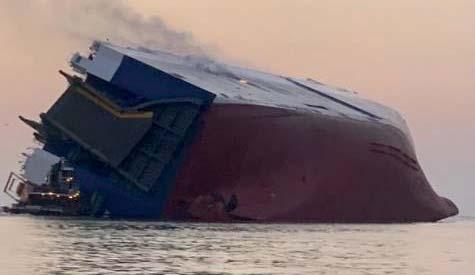
3 minute read
Important messaging
INCORRECT STABILITY CALCULATIONS COST $62.5m
Inaccurate stability calculations caused the capsizing of vehicle carrier Golden Ray, the US National Transportation Safety Board has said
The Marine Accident Report details the NTSB’s investigation of the Sept. 8, 2019, capsizing of the roll-on/roll-off vehicle carrier Golden Ray as it transited outbound through St. Simons Sound near Brunswick, Georgia. All 23 crewmembers and one pilot on board were rescued, including four engineering crew who were trapped in the vessel for nearly 40 hours. Two crewmembers sustained serious injuries. The Golden Ray sustained signifi cant damage due to fi re, fl ooding and saltwater corrosion and was declared a total loss estimated at $62.5 million. An estimated $142 million worth of cargo, including more than 4,100 vehicles, was also lost.
Less than 40 minutes after leaving port, the 656-foot-long Golden Ray began to heel rapidly to port during a 68 degree turn to starboard. Despite attempts by the pilot and crew to counter the heel, the rate of turn to starboard increased, and the vessel reached a heel of 60 degrees to port in under a minute before it grounded outside of the channel.
The NTSB determined the probable cause of the near capsizing of the Golden Ray was the chief officer’s error entering ballast quantities into the stability calculation program, which led to his incorrect determination of the vessel’s stability and resulted in the Golden Ray having an insufficient righting arm to counteract the forces developed during a turn while transiting outbound from the Port of Brunswick through St. Simons Sound. Contributing to the accident was G-Marine Service Co. Ltd.’s (the vessel’s operator) lack of effective procedures in their safety management system for verifying stability calculations.
The NTSB concluded the Golden Ray did not meet international stability standards at departure and possessed less stability than the chief officer calculated.
According to the NTSB, after the vessel capsized, open watertight doors allowed flooding into the vessel, which blocked the primary egress from the engine room, where four crewmembers were trapped. Two watertight doors had been left open for almost two hours before the accident. No one on the bridge ensured that the doors were closed before departing the port.
“The circumstances of this accident show that even when transiting in protected waters, watertight integrity is critical to the safety of the vessel and its crew,” the report said. “It is essential that the operator ensure that crews verify that all watertight doors are closed in accordance with safety management system procedures.”
As a result of its investigation, the NTSB issued two safety recommendations to G-Marine Service Co. Ltd.: 5 Revise its safety management system to establish procedures for verifying stability calculations and implement audit procedures to ensure their vessels meet stability requirements before leaving the port; and 5 Revise its safety management system audit process to verify crew adherence to the Arrival/Departure Checklist regarding the closure of watertight doors.
The public docket for the investigation contains more than 1,700 pages of factual information, including interview transcripts, photographs and other investigative materials and is available online at https://go.usa.gov/xFKfT
The Marine Accident Report is available at https://go.usa. gov/xMWcn
8 The stern view
of the Golden Ray six hours after the heeling event
Simple liferaft exchange
Ship managers and owners can now benefi t from a simple and fast liferaft exchange with no contract and no commitment.
Lalizas’ Fast & Independent (F&I) Liferaft Exchange embraces the most beneficial aspects of the traditional liferaft ‘ownership’ model while also offering the operational benefits of liferaft ‘exchange’.
Designed without entry or exit costs, F&I offers immediate ownership of newly serviced & fully approved liferafts of the same capacity & type as the ones that are currently onboard, ensuring the vessel compliance with IMO standards.
Lalizas has appointed Malcolm Barratt as F&I Liferaft network development manager.
Barratt commented: “F&I is not about to take the place of the traditional ownership Service or Rental of rafts way of working with liferafts - if you consider that approximately two thirds of all liferafts in the world market are still owned by vessels and get a service when due. Likewise, the just less than one third of the global fleet that are not owned by a vessel and are in rental contracts are great for a certain type or profile of Customer. F&I is more a genuine alternative, a third way of working and it is this ‘revolution in the making’ that convinced me to join LALIZAS and to play some small part in delivering this to our industry.”
F&I is available in key ports around the world.




